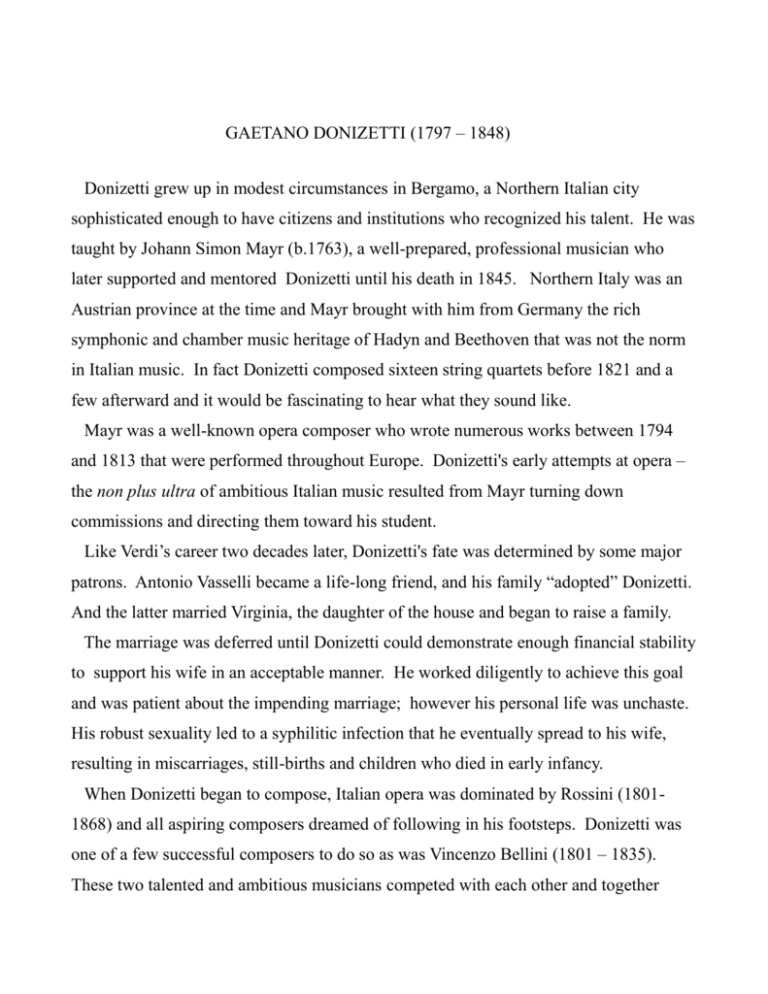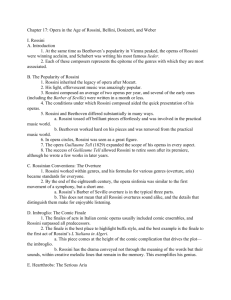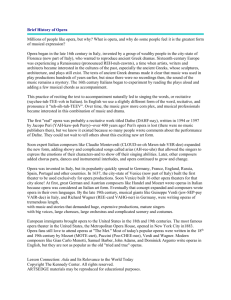here - Institute for LifeLong Learning for New Mexicans
advertisement

GAETANO DONIZETTI (1797 – 1848) Donizetti grew up in modest circumstances in Bergamo, a Northern Italian city sophisticated enough to have citizens and institutions who recognized his talent. He was taught by Johann Simon Mayr (b.1763), a well-prepared, professional musician who later supported and mentored Donizetti until his death in 1845. Northern Italy was an Austrian province at the time and Mayr brought with him from Germany the rich symphonic and chamber music heritage of Hadyn and Beethoven that was not the norm in Italian music. In fact Donizetti composed sixteen string quartets before 1821 and a few afterward and it would be fascinating to hear what they sound like. Mayr was a well-known opera composer who wrote numerous works between 1794 and 1813 that were performed throughout Europe. Donizetti's early attempts at opera – the non plus ultra of ambitious Italian music resulted from Mayr turning down commissions and directing them toward his student. Like Verdi’s career two decades later, Donizetti's fate was determined by some major patrons. Antonio Vasselli became a life-long friend, and his family “adopted” Donizetti. And the latter married Virginia, the daughter of the house and began to raise a family. The marriage was deferred until Donizetti could demonstrate enough financial stability to support his wife in an acceptable manner. He worked diligently to achieve this goal and was patient about the impending marriage; however his personal life was unchaste. His robust sexuality led to a syphilitic infection that he eventually spread to his wife, resulting in miscarriages, still-births and children who died in early infancy. When Donizetti began to compose, Italian opera was dominated by Rossini (18011868) and all aspiring composers dreamed of following in his footsteps. Donizetti was one of a few successful composers to do so as was Vincenzo Bellini (1801 – 1835). These two talented and ambitious musicians competed with each other and together worked their way from Rossini's style into one that had less rigid form and more dramatic expression. While Rossini, Donizetti and Bellini are the “big three” of bel canto opera, the dominant style of the first half of the nineteenth century, they had different musical experiences. Rossini had a meteroic career from which he retired in 1830, although he lived for another 30 years as an eminence grise in Paris. Bellini died young, so his output was relatively small but high in quality; much of it remains in the repertory today. Donizetti wrote 70 operas; a small number are war horses, others are occasionally performed, but most are unknown even to the most avid of opera aficianados. While Lucia, Don Pasquale, The Elixir of Love and Daughter of the Regiment are well known and several others occasionally performed (Anna Bolena, Lucrecia Borgia, Roberto Devereux, Poliuto, Belisario, Linda di Chamounix), the vast majority cannot be found on either CD or DVD and are rarely heard. Donizetti grew up when Rossini's brilliant way with melody and rhythm were expressed in comedies that are still popular today and whose tragedies were well received in his own day and occasionally revived now. Rossini’s work established among the audiences and impresarios of the time expectations about the types of arias they would hear and their order in the opera. Along with these “formulas” were the allpowerful singers, often paid five to ten times what the composer received, who made demands and expected composers to tailor the music to their voices. Donizetti's first decade of work clearly fit in this tradition. After some early successes in Northern Italy (thanks to Mayr’s help) Donizetti set his sights on having a national career. A work from this period is Alahor in Granata, produced in 1826. We shall see that he learned the lessons or Rossini well and produced an opera full of dramatic moments and star turns, especially for the prima donna. At this time he had a year-long contract with the Teatro Carolina in Palermo and thereafter signed a contract with the famous impresario, Domenico Barbaia (1778 - 1841) in Naples. The contract stipulated four operas in three years at 200 ducats a month, and it was significant enough to permit his marriage to Virginia in Rome on June 1, 1828. His career now advanced very rapidly. In 1829 he was appointed Music Director of all the Naples Royal theaters, a job he held until 1838. These were also the years of Bellini’s early successes, so there seemed to be two bright stars on the horizon just at the time that Rossini retired. Donizetti was able to pursue his ambition for ever more dramatic operas. The breakthrough was Anna Bolena and Lucrezia Borgia of 1833. His fees continued to grow and he was able to hire the best singers of the time. (Normally the impresario of each opera house hired a company of singers who sang all the operas commissioned for that season. Sometimes composers had a say in who was hired and always wanted to control the hiring process.) During this period he also wrote The Elixir of Love, a comedy still produced in opera houses around the world. His artistic growth was matched at this time by Bellini’s La Sonnambula and I Capuleti et I Montecchi. The two men were now recognized as the best opera composers in Italy. Paris was the capital of the opera world. It had the largest and most technologically advanced theaters and the most sophisticated audiences and critics. A new kind of opera developed there – large scale productions with huge orchestra and chorus, four or five acts, and a ballet. Rossini ran the Theatre Italien there, a house that specialized in Italian opera with Italian singers and produced works by both Donizetti and Bellini, who composed in the new “grand” style, including the latter’s final work I Puritani. Both were honored by being inducted into the Legion d’honneur – indicating that they were leaders in their field. For Donizetti, this opportunity lead to Lucia di Lammermoor, 1835, one of his all time famous operas. A less famous work of the period, but sung by the soprano who created Lucia the year before was Pia de’ Tolomei , written for La Fenice opera house in Venice and based on a contemporary play telling a gruesome story set in the Italian early Renaissance. The following year it was repeated successfully with the lead taken by Giuseppina Strepponi, the future wife of Giuseppe Verdi. While Donizetti’s professional life was advancing, his personal life was tragic, with a son born in 1837 who immediately died, a wife in increasingly poor health leading to her death at the age of 28. Even though two of his most famous comedies, The Daughter of the Regiment and Don Pasquale, come from the second half of his career, starting in the late 30s on Donizetti turned more insistently to tragedies. The reason was not just a reflection of his personal life, but also a major change that took place in his professional situation. An important opportunity opened up in Naples as a search was on for a new head of the Conservatory there. He was actively in the running but was passed over for Mercadante, a native son. (Because Donizetti was born in Bergamo, he was considered a foreigner in Naples). He had also planned a major premiere in Naples for Poliuto, a new opera and was bringing a very famous French tenor, Alphonse Nourrit, for his first performance in Italy. However, because of the religious subject, the conservative censors in Naples cancelled the opera. This was apparently the straw that broke the camel’s back, and Donizetti did something he had probably been anticipating anyway, he moved to Paris. Poliuto premiered in Paris under a new title, Les Martyrs, in 1838, and was a major success. In fact Donizetti became a musical phenomenon in Paris. He revised previous works, created new ones; in one year he produced seven different operas at three theaters. His creativity and capabilities were almost beyond belief, and he aroused strong jealousy among composers who were having trouble getting even one opera produced in a year, including Berlioz. In the late 30s, Donizetti had three operas that were among the most popular of the age: La Favorite (a new opera), Lucrezia Borgia, and Lucia. Since his earliest days he had connections to the musical establishment in Vienna. Remember that the northern Italy of his upbringing was an Austrian province, and many of the cultural officials in all areas, including music, were known both in Italy and the Austrian capital. Toward the end of this career, he received commissions and honors there. One of his last operas Linda di Chamounix was written for Vienna. Based on a French contemporary play and composed quickly, following his watchwords of “ brevity and clarity”, it was a tremendous success and is still in the repertory. He also was appointed to a mainly symbolic but very well paid position as Kapellmeister to the Viennese royal court in 1842. While this late period of his creative life demonstrated an incredibly capacity for work and accomplishment, including the writing of perhaps his most popular comedy, Don Pasquale, he eventually succumbed to illness. The last five years of his life were spent in ever worsening stages of syphilis, which eventually killed him.







